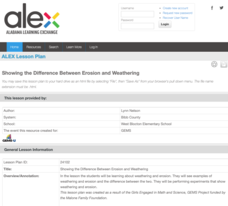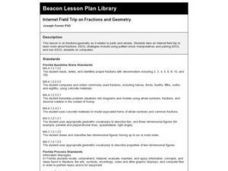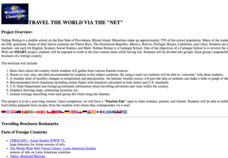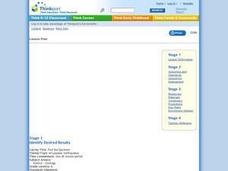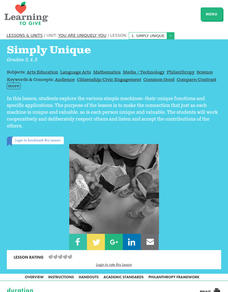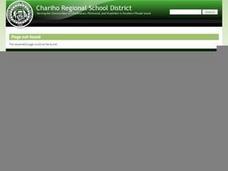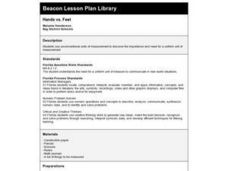Alabama Learning Exchange
Showing the Difference between Erosion and Weathering
Learners explore the concepts of weathering and erosion. After viewing pictures of both erosion and weathering, young scholars work in pairs to conduct an experiment with sugar cubes, water, sand, and a straw. They write their...
Curated OER
Extraordinary Extrapolation
Learners study how scientists have estimated the maximum height to which trees can grow, and assess the reliability of interpolation and extrapolation techniques by making predictions with particular data sets and analyzing accuracy of...
Curated OER
The Dewey Decimal System -- Cataloging Collections
Students categorize their private book collections as a precursor to learning the principles of the Dewey Decimal System. They use the Internet to gain a better understanding of the Dewey Decimal System.
Curated OER
Equivalent Equations
Answer the age-old question every middle schooler has, what are equivalent equations? Here, they will explore the concept, discuss what equivalent equations are, and how to solve them. They also discuss performing an operation on both...
Curated OER
Making the Connections
Use a Horton Chart to identify relationships between numbers and make equivalent fractions and decimals. Scholars change a fraction to find the greatest common factor, find percents, and make equivalent decimals.
Curated OER
Internet Field Trip on Fractions and Geometry
Students take an Internet field trip to research fractions. ESOL strategies include using pattern block manipulatives and pairing ESOL and non-ESOL students on computers.
Curated OER
Money Talks Canadian Money
Learners use newspapers, games and journal writing activities to examine the importance of money and the role it plays in daily life. They complete several math problems, fill out worksheets and practice changing varying amounts.
Curated OER
Help! I Need Five Minutes to Study
Students learn to use a time grid or a calendar to increase productivity of their studying. In this studying lesson, students record how they spend their studying time and then adjust as needed. Students recognize various...
Curated OER
What's the Hold-Up?
Students explore the current plan by New York City Mayor Michael Bloomberg to retain underperforming third graders in public schools. They research and debate social promotion versus retention.
Project SMART
Travel the World Via the "Net"
Middle schoolers work together to create a travel brochure of a foreign country of their choice. They use the Internet to research their information. They create graphics showing interesting locations. They write in their journals at the...
Curated OER
SWOOP Reading
First graders read fluently. In this phonics lesson plan students practice reading strategies for fluency. They write a response in their journal about the book read in class.
Curated OER
Census Sensibility
Students examine the importance of the census and census data collection methods. They gather statistical data, create graphs comparing state and national populations, and compose written reflections on why the census is necessary.
Curated OER
Find the Epicenter
Eighth graders visit the Virtual Earthquake Web site and complete activities that demonstrate how geologists locate the epicenters of earthquakes. The site uses actual data from historic earthquakes.
Curated OER
Similar and Congruent Triangles
Students create and classify different types of triangles using an online geo-board. They explore the concepts of similar and congruent as they discover how to draw similar and congruent triangles.
Curated OER
Measure Me!
Third graders use nonstandard concrete methods to estimate and record measurements of their body.
Curated OER
Understanding Radios
Fifth graders explore ratios. Using models and real-world scenarios, they complete tables and generate comparisons. Pupils demonstrate multiple ways of writing ratios and describe the differences between ratios.
Curated OER
Simply Unique
Students identify, compare and contrast simple machines and their functions. They work together in groups to complete experiments using the simple machines. They write in their journals to reflect on the lesson.
Curated OER
Art: Mirror Of History
Learners show through art how major human events have changed American Culture. Students write in a journal to keep track of studying that is done during the unit. They also create an oral report.
Curated OER
How We Have Changed!
First graders practice using their writing skills. They create memory books through the use of daily journal writing questions of the day. Students respond to story prompts and write autobiographies of themselves and another classmate.
Curated OER
Water-our Precious Resource
Students complete a unit of lessons on water as a limited resource. They conduct Internet research, record information in electronic journals, utilize spreadsheets, conserve water and record the results, and conduct water safety tests on...
Curated OER
Express Yourself: Make Art From Your Ideas
Pupils analyze and discuss various sculptures by the artist Andrea Arroyo. They discuss ways artists use symbols to express abstract ideas, design and create a plasticine plaque, and write a journal response.
Curated OER
Hands Vs. Feet
First graders use unconventional units of measurement to discover the importance and need for a uniform unit of measurement.
Curated OER
Let's Make Lemonade Lesson 3: What's the Big Idea?
Students examine and decide on a service-learning project to perform. They design and execute posters that advertise the project using geometric shapes.
Curated OER
That Rascal Pascal
Fourth graders use the concept of number patterns to complete a portion of Pascal's Triangle as well as identify and describe the patterns represented.
